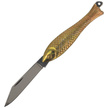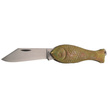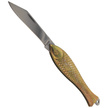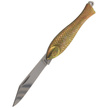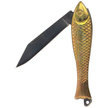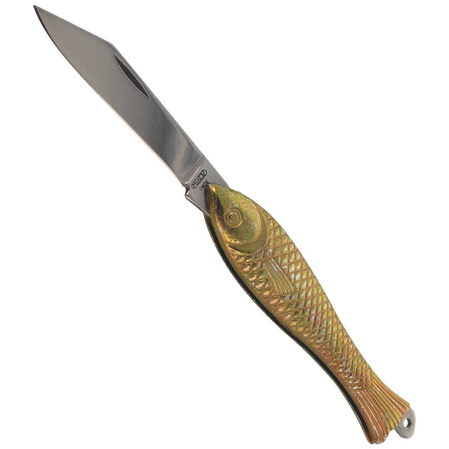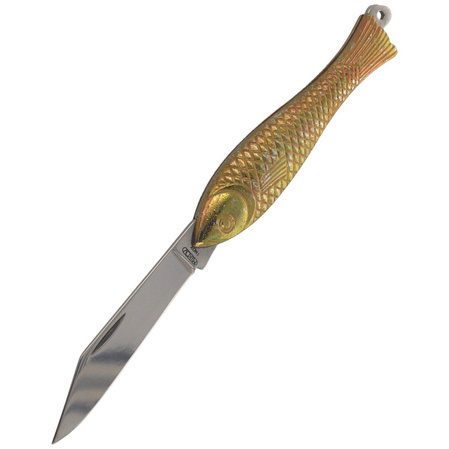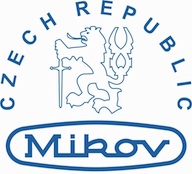The Fishlet Mikov Retro Pocket Knife, Rybička (130-NZN-1/ZL)
- Fishlet is one of the few products in the world that has been produced for generations without changing its appearance for over 100 years. The best-selling Mikov knife.
Fishlet folding knife <Czech Rybička>, <ang. Fishlet> by Mikov with a handle in a fashionable gold-copper color. One of the few products in the world that has been produced for generations without changing its appearance, estimated to be over 100 years. A legend that evokes nostalgia from childhood memories, bringing a smile to the face of its owner.
Fishlet is Mikov's best-selling knife. One of the four products of the company which has been awarded the title of "Regional Product" in the Czech Republic. Simple pocket knife that can be used as a key ring.
Blade - about 1.3 mm thick, made of 420 stainless steel. Smooth blade (Plain type) wa made with a Full Flat Grind, which, combined with the small thickness of the blade, reduces the weight and provides good cutting properties. The knife is opened with a notch on the nail nick.
Handle - copper bronze fading into gold color. Fish scale grip covers cast from zinc alloy. In the back of the claddings there is a hole for attaching a knife to a key ring with a keychain.
Technical Specification:
Product Number: 130-NZn-1/ZL (V1707651)
Name: The Fishlet Retro Pocket Knife
Type of Steel: AISI 420
Blade hardness: 53-55 HRC
Blade length: 55.0 mm / 2.17"
Blade thickness: 1.3 mm / 0.05"
Overall length: 133.0 mm / 5.24"
Blade width: 11.0 mm / 0.43"
Weight: 30.0 g / 1.06 oz
Cutting edge type: Plain
Handle material: Zinc
Manufacturer: Mikov s.r.o., Czech Republic
Created by Sharg® Company - direct importer
Przeczytaj!
This product is intended for use only by adults with knowledge and experience in handling sharp cutting tools. Improper use of the knife can result in serious injuries. The blade is extremely sharp and can easily cut through skin and tissue; therefore, extra caution should always be exercised while cutting, and hands should be kept away from the cutting edge. To prevent the knife from slipping, it is recommended to cut on a stable, non-slip surface and avoid excessive force, which may cause uncontrolled blade movement.
Leaving the knife on the edge of a table, countertop, or in easily accessible places—especially where children are present—poses a significant safety risk. The knife should always be properly secured after use, ideally by placing it on a stable surface or storing it in designated knife blocks, protective sheaths, or magnetic strips. The knife should never be used for tasks it is not designed for, such as opening cans or prying objects, as this can damage the tool and lead to dangerous accidents.
A dull blade increases the risk of injury, as it requires more force and is more likely to slip from the material being cut. Therefore, it is essential to sharpen the knife regularly to maintain optimal sharpness. Additionally, proper cleaning and drying of the knife are necessary to prevent corrosion and bacterial growth. Periodic inspection of the handle and blade is recommended to check for cracks, chips, or looseness. If any damage is detected, the knife should be repaired or replaced immediately.
When using the knife, focus solely on the task at hand—avoid talking on the phone, watching television, or other distractions while cutting. Ensure proper lighting in the workspace for better visibility and control. Please note that some countries or regions have laws restricting the ownership and carrying of knives. Before purchasing or using this knife, verify that its use is legal in your location according to applicable regulations.
Following these safety guidelines will help ensure safe and effective knife use, minimizing the risk of accidents and extending the lifespan of the tool.

